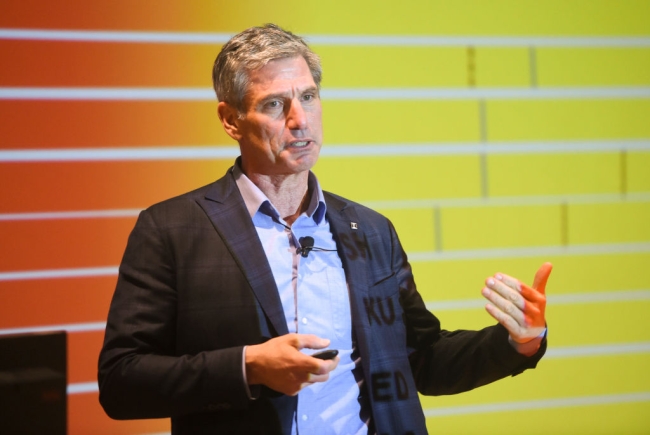You have /5 articles left.
Sign up for a free account or log in.

Pennsylvania State System of Higher Education Chancellor Daniel Greenstein.
MediaNews Group/Reading Eagle via Getty Images/Contributor
The Pennsylvania State System for Higher Education recently approved plans to consolidate six universities into two institutions -- one in the northeastern part of the state and another in the west. The road to board approval was long, marked by multiple proposals and riddled with public opposition.
Now, Daniel Greenstein, chancellor of the system, and Christine Smith, managing director of higher education and risk advisory practices at Baker Tilly and a consultant on the project, look ahead to the next phase of the consolidation process: implementation.
Over the next year, PASSHE will combine leadership at the universities involved, seek approval from its accreditor -- the Middle States Commission on Higher Education -- and begin creating an integrated curriculum.
Inside Higher Ed recently spoke to Greenstein and Smith about the board approval process and the planned implementation.
The following interview has been edited for length and clarity.
You've made it through the first part of this integration process -- getting it approved. What are the most pressing next steps?
Greenstein: I think the biggest challenge is changing leadership. You've got leadership at three universities that have all been culturally independent, organizationally independent, accredited, and around for a long time, and you've got to build something new. A new blended culture -- respectful of what's been historically and maintaining that distinctiveness, but also getting folks to think about how we're now together and it's a new world.
Smith: Baker Tilly is really leading a comprehensive stakeholder mapping project and process with integrating universities so that those transitional leaders can really establish the change networks that they're going to work with and collaborate with. How do we build on existing engagement or governance processes that are already in place at each campus?
The second most important thing, in my mind, is having that stakeholder engagement plan that thinks about where do we have the right people at the right time to get the right input, and then how are we making sure that there's a two- way feedback process communicating back with each unique stakeholder group?
Who will be included on the leadership team?
Greenstein: We have one president who is now president of all three universities in the Northeast and one in the West. So we've integrated the presidencies under a single person for each group of institutions. Each of the universities has their own leadership team which reports up to that president, but they've also put in place a transitional team, which is responsible for building the new entity.
Who are the two new presidents?
Greenstein: President Bashar Hanna was president at Bloomsburg and is now also interim president at Lock Haven and Mansfield -- the Northeast institution. And then Dale-Elizabeth Pehrsson, who was originally president at Clarion, is now also interim president at Edinboro and California -- the West institution. (This paragraph has been updated to say which institution is in the west and which is in the northeast.)
There's been some concern among students about whether the consolidated institutions will still be eligible for NCAA athletics. Do you have any information from the association about whether sports will remain on each campus?
Greenstein: It's really important for a whole bunch of reasons that we are able to preserve our teams, and that's our objective. We're pursuing it very continually with the NCAA, but there was never any question in my mind about the NCAA [decision] coming out ahead of the board. And frankly, I will be surprised if they actually come out in advance of Middle States.
Middle States -- as I refer to it in a loving way -- is the ship in the middle of the Suez Canal. It's not beached, but it's just big. And all of the other accreditors and regulators are behind it and they're waiting to sail through the canal.
What does the timeline for approval from Middle States look like?
Smith: September is when the official request will go in. Then in March of 2022, the Middle States commission meets and we're hoping they will consider the request, and that they will make a decision about accreditation. And then the effective date of that accreditation will be sometime in the summer of 2022.
Can you talk more about the plans to create an integrated curriculum? How will that process work?
Greenstein: The original plan was to have a curriculum blended by August 2022 -- the date at which the integrated universities would enroll their first cohort of students. We got a lot of feedback during the public comment period -- not just from faculty but also from staff, because there's a lot of technology and other supports that go along with blending a curriculum.
We're looking forward to having in the fall a very specific, detailed plan: over the next three years, this is the pace at which parts of the curriculum will be blended. So we'll have the details in a few months.
Several people have told me that students and faculty members were not satisfied with how the system sought and considered public comments. Will the system do anything differently during the implementation period?
Greenstein: I think we all did take the comments we received very, very seriously. In fact, folks on both sides of the aisle said 'I've never seen anything so transparent.' Go out and find another integration plan on the web, for example. Usually this work is done much more closely held, and decisions are made before there is really any significant degree of transparency.
I thought it was the right thing to do, both given our culture and our history and the distinctive qualities of our universities. And, frankly, because I thought we're going to get a better product.
Smith: I think the challenge in the implementation phase for those regional teams and Baker Tilly as the project manager is to make sure that communication about how the [public comment] feedback was received -- and specifically put in the plans -- is crystal clear and is shared with every stakeholder group in a way that they need to hear it. I think that's one of the things that we can take to heart and really make sure that we rethink the approach and the processes.
But I think this has been an extremely well-designed and -executed process, both from the design phase and from involving the right people and stakeholders and making sure that there were multiple opportunities for input.




